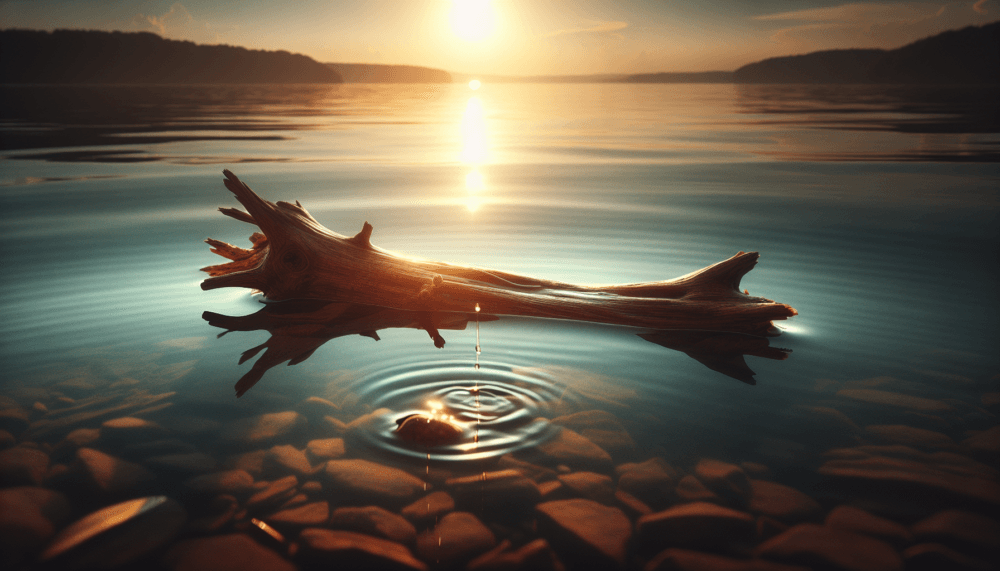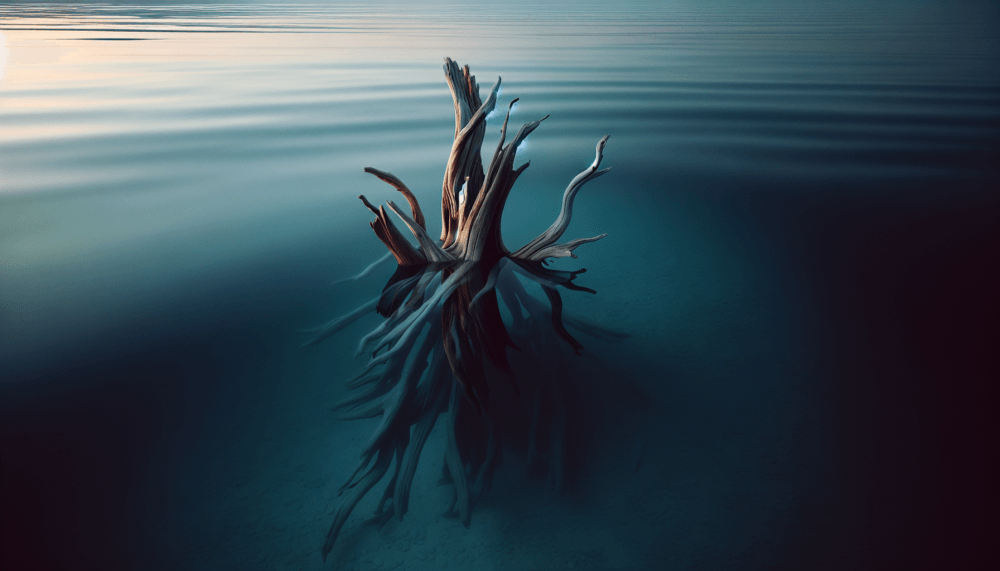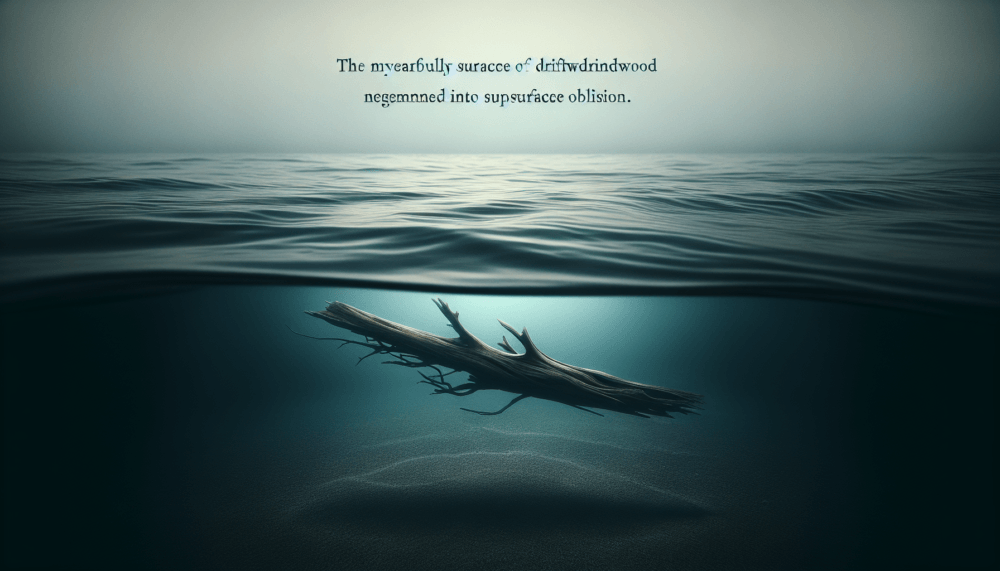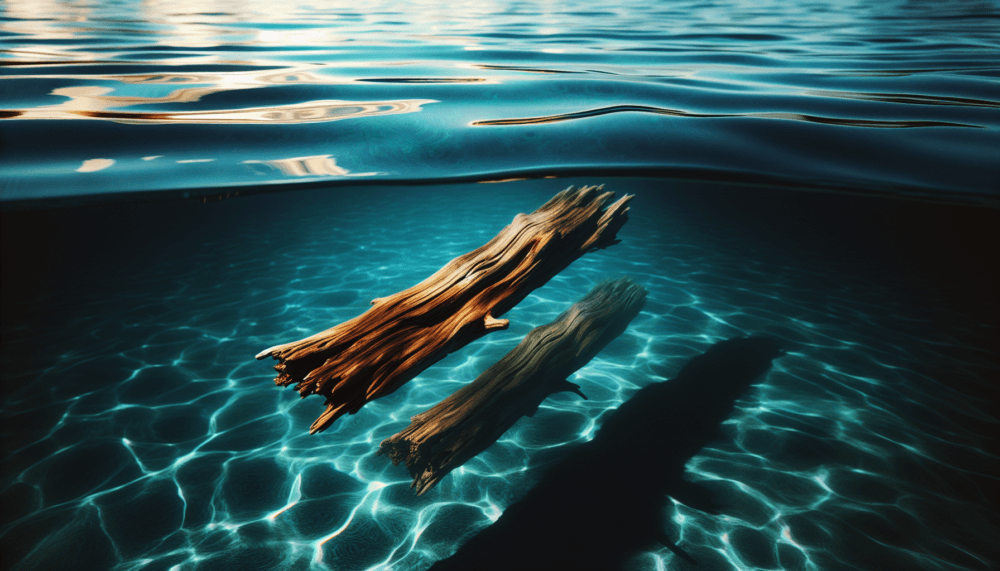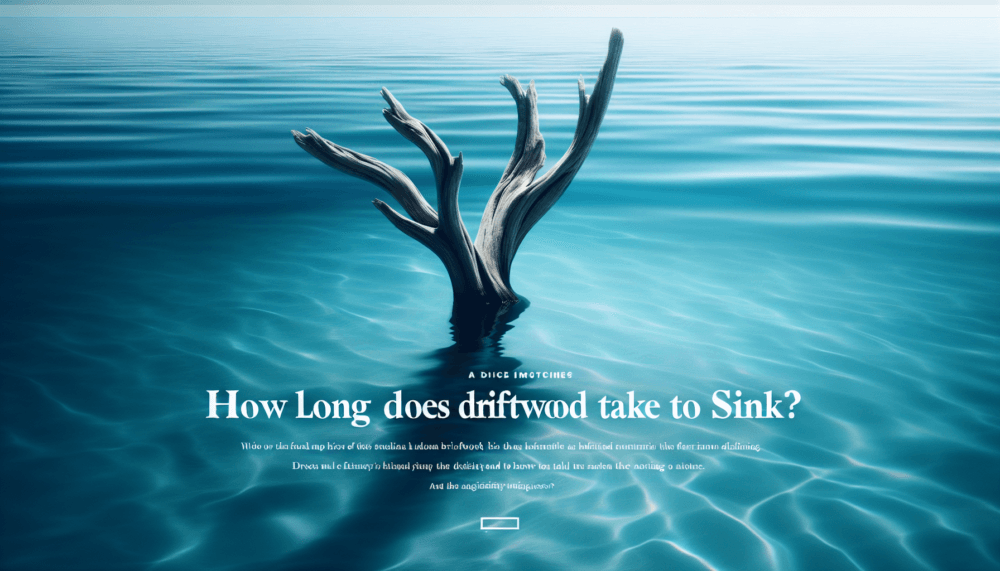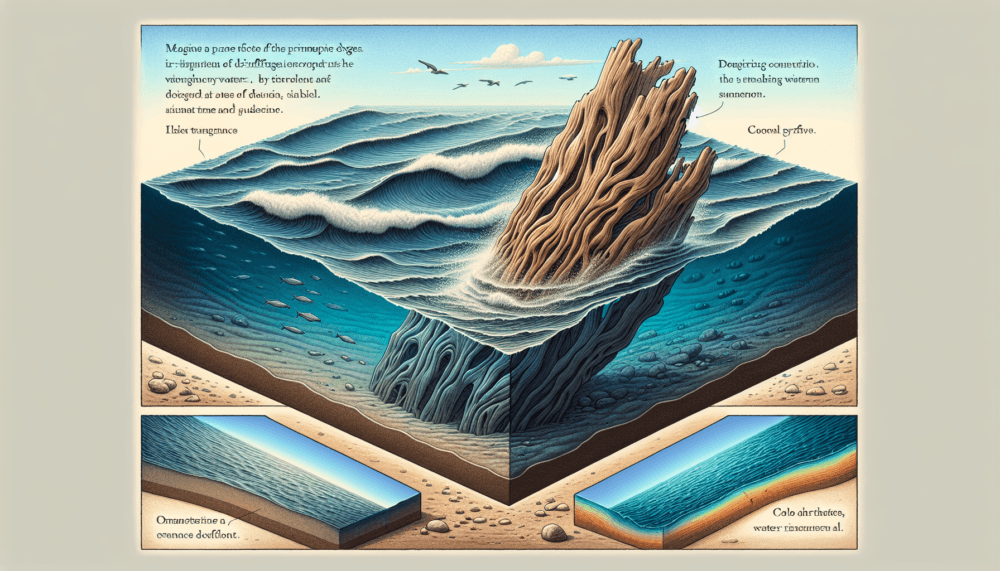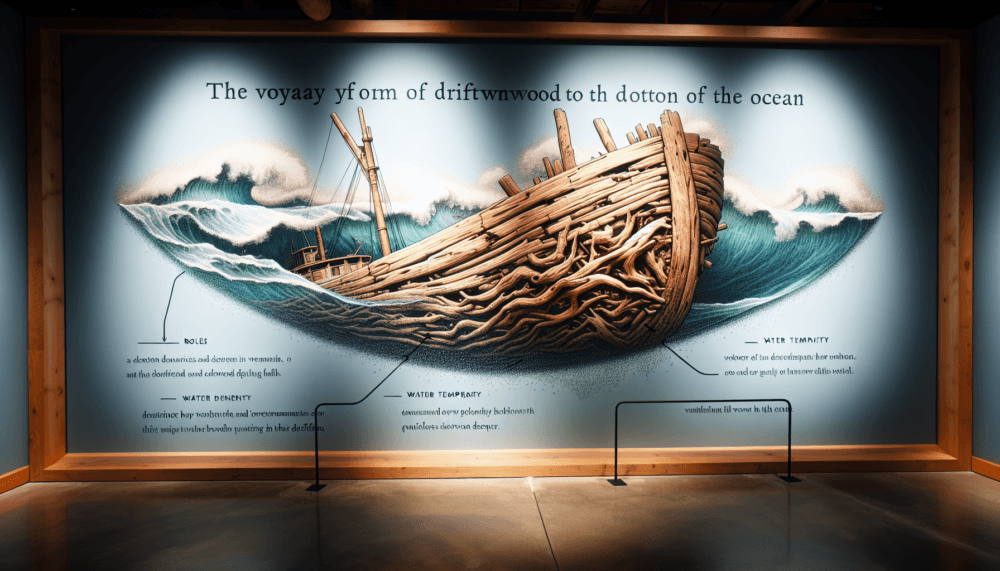So you’ve collected some beautiful pieces of driftwood and now you’re wondering how to make them sink for that perfect aquarium or terrarium setup. Look no further! In this article, we’ll explore simple yet effective methods to help you achieve your desired sinking effect with your driftwood. Whether you’re a seasoned hobbyist or just starting out, these techniques will ensure that your driftwood stays right where you want it, creating a stunning and natural underwater environment for your aquatic pets or plants.

Why Do You Need to Make Driftwood Sink?
Driftwood is a popular and aesthetically pleasing addition to aquariums and aquatic habitats. Its natural beauty and unique shapes can enhance the overall visual appeal of the tank, creating a more natural and realistic environment for your fish and other aquatic organisms. However, one common issue with driftwood is that it tends to float on the surface of the water, disrupting the balance and stability of the tank. That is why it is essential to make driftwood sink, ensuring that it stays in place and doesn’t cause any disturbances to the aquatic ecosystem.
Benefits of sinking driftwood in aquariums
There are several benefits to sinking driftwood in aquariums. Firstly, by making the driftwood sink, you can achieve a more realistic and natural-looking setup for your aquarium. The submerged appearance of the driftwood can mimic the fallen branches and trees found in natural bodies of water, creating a more visually appealing and authentic habitat for your aquatic inhabitants.
Secondly, sinking driftwood allows for better utilization of the entire water column in the tank. When driftwood floats on the surface, it creates a barrier that restricts the movement and access of aquatic organisms to the upper water levels. By sinking the driftwood, you provide a vertical structure within the tank that fish and other inhabitants can freely swim around and interact with.
Lastly, sinking driftwood improves the overall stability of the aquarium. Floating driftwood can be easily displaced by water flow or the activities of the tank inhabitants, causing it to shift position or even float to the surface. This can lead to potential damage to plants, disruption of landscaping, or even injury to the aquarium inhabitants. Making the driftwood sink eliminates these risks and ensures that your aquarium remains harmonious and in balance.
Preventing floating driftwood in aquatic habitats
Floating driftwood can be a frustrating problem for aquarium enthusiasts, but with some careful preparation and techniques, it can be easily avoided. By following specific steps and methods, you can ensure that your driftwood stays firmly grounded in your aquatic habitat.
Preparing the Driftwood
Before you start the process of sinking driftwood, it is essential to prepare the pieces properly. This ensures that they are safe for the aquarium and helps them sink more effectively.
Selecting suitable driftwood pieces
When choosing driftwood for your aquarium, it’s important to consider certain factors. Look for pieces that are sturdy and will not easily break or fall apart. Avoid driftwood with sharp edges or splinters, as these can be harmful to your aquatic creatures. Additionally, consider the size of the driftwood in relation to the size of your tank. Overly large or overcrowded driftwood can negatively impact the aesthetics and functionality of the aquarium.
Cleaning the driftwood
Before submerging the driftwood, it’s crucial to clean it thoroughly. Start by rinsing off any visible debris, such as dirt, algae, or other unwanted particles. Then, scrub the driftwood gently with a soft brush to remove any stubborn dirt or algae. Avoid using any harsh chemicals or cleaners, as they can be toxic to aquatic life. After cleaning, rinse the driftwood thoroughly to ensure that no residue remains.
Boiling the driftwood
Boiling the driftwood is another effective method to prepare it for sinking. Boiling helps to remove any remaining impurities, kills off potential parasites or bacteria, and reduces the chances of decay. To boil the driftwood, place it in a large pot and cover it with water. Bring the water to a boil and let the driftwood simmer for at least 1-2 hours. Allow the driftwood to cool before handling it to avoid burns.
Soaking the driftwood
Soaking the driftwood is an additional step that can aid in sinking. Fill a container or bathtub with water, ensuring there is enough water to submerge the driftwood fully. Place the driftwood in the water and weigh it down with a heavy object, such as a rock or brick. Let the driftwood soak for several days or until it becomes waterlogged and sinks naturally. This process helps to remove excess tannins from the wood, which can cause water discoloration and affect the pH levels of the aquarium.
Creating Weighted Bases for Driftwood
To ensure that the driftwood remains submerged in the aquarium, you can create weighted bases that hold it firmly in place. There are several techniques you can employ to achieve this.
Using fishing sinkers
One simple method is to attach fishing sinkers to the lower end of the driftwood. Fishing sinkers are readily available at most fishing supply stores and are typically made of lead or other heavy materials. By securely fastening fishing sinkers to the driftwood using a fishing line or aquarium-safe adhesive, you can add enough weight to make the driftwood sink and stay in place.
Using epoxy putty
Epoxy putty is another excellent option for creating weighted bases for driftwood. Epoxy putty is a two-part adhesive that, when mixed together, forms a durable and solid material. Mold the epoxy putty around the lower section of the driftwood, shaping it into a weighted base. Allow the epoxy putty to harden according to the manufacturer’s instructions. The hardened epoxy putty will provide sufficient weight to keep the driftwood submerged.
Using rocks or stones
If you prefer a more natural-looking alternative, you can use rocks or stones to create weighted bases for the driftwood. Look for large and heavy rocks that are suitable for aquarium use, ensuring that they are smooth and non-toxic. Carefully arrange the rocks or stones around the base of the driftwood, positioning them in a way that adds stability and prevents the driftwood from floating. This method not only helps to sink the driftwood but also adds a touch of authenticity to the aquarium setup.
Using Driftwood Anchoring Techniques
In addition to weighting the driftwood, various anchoring techniques can be employed to keep it securely in place. These techniques help to prevent the driftwood from shifting or floating due to water currents or the activities of the tank inhabitants.
Tying the driftwood to a weight
One effective technique is to tie the driftwood to a weight at the base of the aquarium. Use a sturdy fishing line or aquarium-safe rope to fasten the driftwood to the weight. Be sure to tie it tightly and securely to prevent any movement. The weight can be a heavy rock, a ceramic ornament, or any other object that will hold the driftwood in place. This method ensures that the driftwood remains grounded even if there are strong water currents in the tank.
Using suction cups or magnets
Suction cups or magnets can also be utilized to anchor the driftwood. Attach suction cups or magnets to the base of the driftwood and affix them to the sides or bottom of the aquarium. Ensure that the suction cups or magnets are strong enough to support the weight of the driftwood. This method allows for easy removal and repositioning of the driftwood if needed.
Attaching the driftwood to a slate
Another anchoring technique involves attaching the driftwood to a piece of slate. Slate is a flat and sturdy rock-like material that provides a stable base for the driftwood. Securely fasten the driftwood to the slate using fishing line, aquarium-safe adhesive, or silicone sealant. Place the slate on the substrate, ensuring that it is stable and well-supported. This method keeps the driftwood in place and prevents it from floating or shifting.

Driftwood Sinking Methods
Now that you have prepared the driftwood and created weighted bases or used anchoring techniques, it’s time to employ specific methods to ensure the driftwood sinks and stays submerged in the aquarium.
Soaking the driftwood in water
One of the simplest methods to sink driftwood is by soaking it in water. Fill a container or bathtub with water, ensuring that it’s deep enough to fully submerge the driftwood. Place the driftwood in the water and weigh it down using rocks or bricks. Allow the driftwood to soak for several days or until it becomes waterlogged and sinks naturally. Regularly check the water to make sure it remains clean and free from any decaying debris.
Burying the driftwood in substrate
If you prefer a more natural look, you can bury the driftwood in the substrate of the aquarium. Prepare the substrate by creating a depression or hole where the driftwood will be placed. Ensure that the depression is deep enough to fully cover and bury the driftwood. Insert the driftwood into the substrate, making sure it is stable and firmly grounded. Cover the driftwood with the surrounding substrate, creating a seamless and natural appearance. Over time, the weight of the substrate will help to sink the driftwood.
Using driftwood weights
Driftwood weights are specially designed products that can assist in sinking the driftwood. These weights are typically made of non-toxic materials and are shaped to fit securely around the base of the driftwood. Simply attach the driftwood weight to the bottom of the driftwood, ensuring it is firmly held in place. The added weight will help the driftwood sink and remain submerged in the aquarium.
Considerations for Different Aquarium Types
When sinking driftwood, it’s important to consider the specific requirements and conditions of your aquarium type. Different aquarium setups, such as freshwater aquariums, saltwater aquariums, and paludariums, may have varying needs.
Freshwater aquariums
In freshwater aquariums, it’s crucial to consider the impact of driftwood on the water chemistry. Driftwood naturally releases tannins into the water, which can cause discoloration and affect the pH levels. While some fish and plants thrive in slightly acidic water, others may require more neutral or alkaline conditions. Monitor the water parameters regularly and make adjustments as necessary to ensure a healthy and balanced environment for your freshwater inhabitants.
Saltwater aquariums
In saltwater aquariums, maintaining water quality is of utmost importance. Driftwood can introduce organic compounds into the water, potentially leading to nutrient imbalances and algae growth. Regular water testing and necessary nutrient controls are essential to prevent any negative effects on coral and other sensitive marine organisms. Additionally, ensure that the driftwood is fully cured and free from any unwanted pests or parasites that may harm saltwater species.
Paludariums
Paludariums are unique setups that combine aquatic and terrestrial elements, typically featuring both water and land areas. When sinking driftwood in paludariums, consider the specific water depth and ensure that the driftwood is appropriately positioned to maintain a balanced and visually appealing environment. Take into account the lighting and humidity requirements of the terrestrial plants and animals in the paludarium to ensure optimal conditions for their growth and well-being.
Maintenance Tips
Once you have successfully sunk the driftwood in your aquarium, it is important to perform regular maintenance to ensure its ongoing stability and well-being of the aquatic inhabitants.
Testing and adjusting water parameters
Regularly test the water parameters, including pH, ammonia, nitrate, and nitrite levels, to ensure they are within the appropriate range for your aquarium. Make any necessary adjustments to maintain a healthy and balanced environment. Monitoring these parameters will help prevent any adverse effects of the driftwood on water quality and the overall ecosystem.
Removal and repositioning of driftwood
Occasionally, you may need to remove or reposition the driftwood in your aquarium. This may be necessary for cleaning purposes or to ensure that it is still safely and securely anchored. When removing driftwood, be careful not to disturb or damage any plants, decorations, or tank inhabitants. Use caution and gentle maneuvers to minimize stress on the aquarium’s ecosystem.
Cleaning and preventing decay
Driftwood, like any other organic material, can decay over time, potentially polluting the water and negatively impacting the aquarium’s health. Regularly inspect the driftwood for signs of decay, such as soft or rotting areas. If decay is detected, remove the affected parts or replace the driftwood entirely. Additionally, perform routine cleaning of the driftwood to remove any algae or debris that may accumulate. A soft brush or algae scraper can be used to gently clean the surface without causing damage.
Alternative Options for Sinking Driftwood
While the methods mentioned above are effective for sinking driftwood, there are alternative options you can explore to achieve a similar effect.
Using artificial driftwood
If you prefer not to use natural driftwood or encounter difficulties sinking it, artificial driftwood is a viable alternative. Artificial driftwood is typically made of resin or other synthetic materials, designed to resemble the appearance and texture of real driftwood. These pieces are often pre-weighted or come with built-in bases, eliminating the need for additional sinking techniques. Artificial driftwood offers the advantage of being more durable and less prone to decay compared to natural driftwood.
Creating DIY weighted driftwood
For those who enjoy do-it-yourself projects, creating DIY weighted driftwood can be a fun and creative alternative. Start with a lightweight piece of driftwood and use the methods mentioned earlier, such as attaching fishing sinkers or using epoxy putty, to add weight to the driftwood. This allows you to customize the sinking process and create unique and personalized pieces for your aquarium.
Using other materials for a similar effect
If you prefer not to use traditional driftwood, there are other materials that can provide a similar aesthetic effect. For example, petrified wood, rocks, or ceramic ornaments can be used to create appealing submerged structures in your aquarium. These materials can be manipulated and positioned to resemble natural elements like branches or fallen trees, offering an alternative approach to achieving a visually pleasing and functional aquarium design.
Safety Precautions
While sinking driftwood can enhance the beauty and functionality of your aquarium, it’s important to prioritize the safety of your aquatic life.
Choosing non-toxic driftwood
When selecting driftwood for your aquarium, ensure that it is non-toxic and safe for your fish and other inhabitants. Certain types of driftwood may release harmful substances or have sharp edges that can injure your aquatic creatures. Always research and choose driftwood species that are known to be aquarium-safe and compatible with your specific tank inhabitants.
Avoiding sharp edges or splinters
Inspect the driftwood carefully for any sharp edges or splintered areas that may pose a risk to the aquarium inhabitants. Sand down or smooth out any rough patches to prevent potential injuries, especially to delicate fish or bottom-dwelling species. Taking these precautionary measures will help maintain a safe and comfortable environment for your aquatic creatures.
Monitoring water quality and health of aquatic life
Regularly monitor the water quality, health, and behavior of your aquarium inhabitants. Any drastic changes in water parameters, signs of stress, or unusual behavior could indicate an issue with the driftwood or its preparation. Address any concerns promptly to ensure the well-being and longevity of your aquarium’s ecosystem.
Conclusion
Making driftwood sink in aquariums is a necessary step to prevent floating and disturbances in aquatic habitats. By selecting suitable driftwood pieces, properly preparing them, creating weighted bases, and employing anchoring techniques, you can successfully sink driftwood in your aquarium. Remember to consider the specific requirements of your aquarium type, perform regular maintenance, and ensure the safety of your aquatic life. With proper care and attention, your sunken driftwood will create a stunning and harmonious natural environment for your aquarium inhabitants to thrive in.



